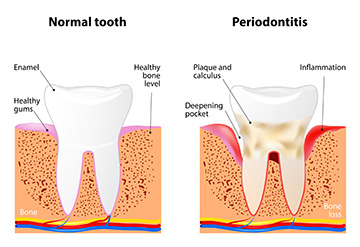Gum Disease Treatment
It’s human to take your health for granted. When you’re young and carefree, it’s easy to believe that you’ll feel vibrant and strong forever.
Unfortunately, things break down when you neglect them — your teeth and gums included.
When you don’t brush or floss regularly, dental plaque, a sticky film filled with bacteria, forms on your teeth.
Dental plaque can infect your gums and the sulcus, the v-shaped crevice just below the gum line.
At this stage, the infection is called gingivitis. If it progresses, it’s called periodontitis. Both are forms of periodontal disease, also known as gum disease.

Symptoms of Periodontal Disease
Swollen gums make brushing and flossing difficult. And bad breath is a social faux pas. But both are actually signs of something much more serious — gingivitis.
These symptoms are often mild, so it’s tempting to ignore them. However, when gingivitis is left untreated, it can develop into the “Big Daddy” of periodontal disease: periodontitis.
Periodontitis destroys the tissue and bone that support the teeth and can cause tooth loss. Periodontitis can also be transmitted to your loved ones via saliva.
Other warning signs of periodontal disease include:
Make Appointment
What Causes Periodontal Disease?
Dental plaque is the primary culprit of periodontal disease. If not removed within 26 hours, dental plaque turns into dental tartar, which causes periodontal disease. You can prevent dental plaque by practicing good oral hygiene. That means brushing and flossing regularly; visiting the dentist for regular checkups and dental cleanings; and maintaining a well-balanced diet.
Other factors can increase the risk of periodontal disease, including:
Treating Periodontal Disease
Fortunately, gingivitis is reversible with professional care and good home dental care. Periodontitis requires more substantial gum disease treatment, however. A non-surgical method of treating periodontitis is the scaling and root planing procedure (SRP).
During a scaling and root planing, your dentist performs a careful cleaning of the root surfaces to remove dental plaque and dental tartar, and then smoothes the tooth root to remove bacterial toxins. Dental surgery for periodontal disease includes pocket reduction procedures, crown lengthening and soft tissue grafts.
